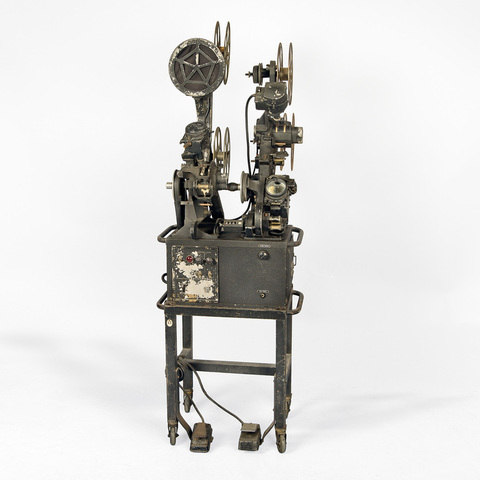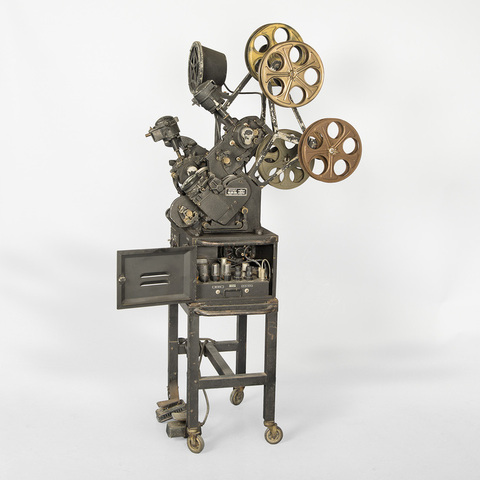Visionneuse de film 35 mm
Fiche détaillée
Type de l'appareil
table métallique supportant à droite une visionneuse 35 mm avec entraînement par croix de Malte, lentille, lecteur son optique, lampe excitatrice, source lumineuse, bras débiteur et récepteur, et à gauche un appareil lecteur de son optique, lampe excitatrice, bras débiteur et récepteur, haut-parleur Jensen ; les deux appareils ont le même axe d'entraînement ; moteur électrique ; amplificateur à tubes ; deux pédales ; compteur de pieds
Auteurs
Serrurier Iwan
Altadena, Californie
Fabricants
Jensen Radio Manufacturing Company
Chicago, Illinois
Moviola Company
Hollywood, Los Angeles, 1451 Gordon Street, California
Utilisateurs
Serrurier Iwan
Altadena, Californie
Distributeurs
Moviola Company
Hollywood, Los Angeles, California
Sujet du modèle
Informations non disponibles
Objectif
7,5 cm diamètre
Taille de l'objet
Ouvert :
Informations non disponibles
Fermé :
Longueur : 75 cm
Largeur : 56 cm
Hauteur : 169 cm
Diamètre :
Informations non disponibles
Taille de la boîte de transport
Informations non disponibles
Remarques
Marque : "Moviola Trade Mark registered. Model DX. Volts 115. Amp. - Cycles AC DC. Serial n° 21 635. Moviola Manufacturing Co. 1451 Gordon St., Hollywood 28, California USA".
"Iwan Serrurier, inventor of the machine and founder of the Moviola Company, had not had any previous contact with the motion-picture industry. The need for an editing machine was pointed out to him in the course of his efforts to sell a machine for showing motion pictures in the home. Sharing in the credit for inventig and perfecting the Moviola are many persons in the industry who contributed their ideas and experiences. Iwan Serrurier was born in Leiden, Holland, in 1878. He attended the University at Utrecht and then went to the University in Zurich, where he obtained a degree in mechanical and electrical engineering. Upon graduation he married his sweetherat in Holland, and soon they were on their way to the United States. [...] Iwan went to work for the Southern Pacific Railroad as a draftsman in the car departement, and then during the World War I, he worked for one of the shipyards in san Pedro. Sometime during this period he became interested in motion-picture projectors. He acquired a used Edison Kinetoscope and some worn out theater projectors. He thought there should be a convenient way for showing movies in the home. He experimented by building some rough cabinets which would serve the dual puropose of containing the projector ready for use and a means of supporting a small screen. These models were the basis for a patent which he received in April 1919. [...] The final assembly was in the garage at home in Altadena. The completed machines were stored in the living room for lack of a better place. Iwan's five children were asked to sumit names for the new machine. Of the twenty or more names suggested, "Moviola" seemed the best. But selling was another matter. [...] During 1923 and 1924 he sold three machines : one to Carter de Haven, one to Victor Pearlman, and one to a store in Pasadena. At about this time he met Maurice Cohen, and they became very close friends. Maurice was a French character actor who knew his way around in all the studios. [...] In September, 1924, they were talking to someone in a cutting room at the Douglas Fairbanks Studio. [...] This man was not interested in the cabinet-type projector, but he thought the mechanism would be useful for film editing, if it could be modified for use on the editing table. The idea sounded good so, over a weekend, one of the mechanisms was modified. Parts were sawed off, it was mounted upside down on a board, a lamp and a magnifying glass were added. On Monday Iwan returned with this hand-cranked contraption for a tryout. The editor was very enthusiastic, and the Douglas Fairbanks Studio purchased the first Moviola Editing Machine. All the surplus mechanisms were modified in this manner and promptly sold. The demand continued, so Iwan designed a machine and had twelve manufactured by Mitchell Camera. These machines carried the name Moviola Midget ; the first of three was sold to MGM in Novembre 1924. After this lot of machines was sold, additional ones were manufactured, some by Mitchell and some by W. S. Austin, who had a one-man machine shop. By 1928 it seemed that the market for editing machines was pretty well saturated, but the advent of sound changed that overnight. In July of that year the first home for Moviola was built in the rear of a residence on Gordon Street in Hollywood. From 1928 to the beginning of World War II the business grew steadily. Quite a few machines were sold to firms in foreign countries. [...] Iwan designed new products and improved the earlier ones. This included sounheads for optical sound (Movietone), turntables for disc recordings (Vitaphone), viewers for 16 mm, 35 mm, and the early 65 mm and 70 mm films, a projector, synchronizers, rewinders, sound readers, and in 1938, the preview machines. World War II brought a sharp increase in demand for Moviola machines to fill military and propaganda needs. Material priorities, manpower shortages, and other wartime refulations combined to make problems which, it seemed, could best be solved by leasing the business to another firm for the duration. So, for the period 1943-1945, the business was operated by General Service Corporation (a division of H.W. Houston). [...] In February 1962, Moviola moved into its new and modern building in North Hollywood" (Mark Serrurier, "The Origins of the Moviola", Journal of the SMPTE, vol. 75, July 1966, p. 701-703).
Bibliographie
Mark Serrurier, "The Origins of the Moviola", Journal of the SMPTE, v. 75, July 1966, p. 701-703.

